The first time we saw the Yeti SB115 TURQ3 our jaws dropped hard. The elegant turquoise finish and Switch Infinity Link suspension make for a unique and unmistakable look. Be warned: the nimble Yeti is damn fast and disappears over the horizon in a flash – very few bikes in this test climb as willingly as the SB115. But can it also convince downhill and does the spec live up to the potential of the bike?
For an overview of the test fleet head to the group test: The best mountainbike of 2021 – 22 models in review

12.38 kg (size L) | € 10,990 | Manufacturer-website
If you want to go for a quiet ride in the forest, the Yeti SB115 TURQ3 might not be the right choice. While you disappear into a cloud of dust, the elegant carbon frame of the Yeti with its trademark turquoise finish and Switch Infinity suspension will let everyone know you’re in the area. Yeti’s proprietary Switch Infinity Link is supposed to improve the bike’s climbing performance. It’s placed right above the bottom bracket and could be mistaken for a double-shaft FOX shock! In reality, it’s a linearly translating pivot that is free to move as the bike moves through its travel, allowing Yeti to tune the suspension kinematics. As the name suggests, the Yeti SB115 offers 115 mm rear travel, complemented by 130 mm travel at the front, controlled by a FOX 34 FIT4 fork. By the way, make sure to lubricate the Switch Infinity Link regularly using a grease gun and while you’re at it, check the link bolts. The lubricating nipple can be reached without tools, making the process quick and easy. Yeti offer the frame in two different grades of carbon fibre: the premium and lighter TURQ carbon, or the C carbon, which is approximately 225 g heavier. Our SB115 TURQ weighs in at 12.38 kg in size L. Regardless of the carbon grade, all frames come with a plastic downtube protector, a splash guard for the Switch Infinity link and a seat and chainstay protector as standard. All cables run through the frame through individual guided channels. The internal routing system looks incredibly tidy and elegant because the cables aren’t clamped at the ports. However, this also makes the otherwise quiet Yeti very loud on the trail.
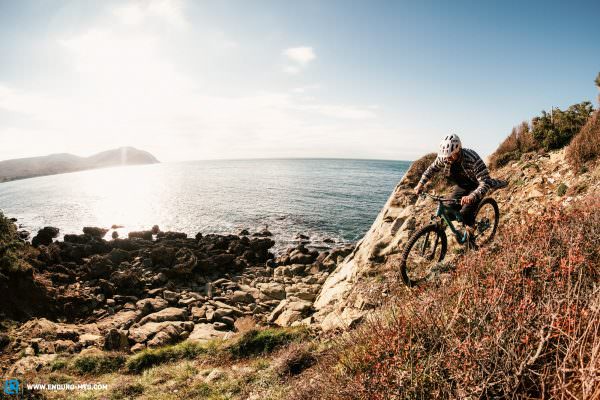

Rocket propulsion – The spec of the Yeti SB115 TURQ3
As soon as you swing your leg over the saddle of the SB115 TURQ3, you feel like you’re sitting on a powerful downhill rig. The tidy cockpit with Yeti’s wide 780 mm carbon bars and short 50 mm stem reminds us of more capable bikes, like the Canyon Spectral. In comparison, the cockpit of bikes with similar travel, like the Trek Top Fuel and MERIDA NINETY-SIX 8000, look crammed and inspire less confidence. Unfortunately, Yeti use a FOX 34 fork with a FIT4 damper on the € 10,990 SB115. We’d happily trade the lockout for the far superior GRIP2 version. In this respect, the Specialized Stumpjumper is one big step ahead, because the superior fork delivers significantly better performance. Braking is taken care of by lightweight SRAM G2 Ultimate four-piston brakes paired with small 180 mm rotors front and rear. Unfortunately, this setup doesn’t do justice to the potential of the bike, leaving the brakes overheating too quickly on long rides. A wireless SRAM XX1 AXS drivetrain with a 10–52 t cassette does shifting duties and a FOX Transfer dropper with 175 mm drop in size L ensures good freedom of movement on the bike.
Sporty riders will love the Yeti SB115 TURQ3 on man-made flow trails. However, at high speeds, you should be careful because the rear end lacks progression and tends to bottom out harshly and suddenly.
The Yeti rolls on MAXXIS tires with the thin EXO casing: at the front you get a DHF in the soft 3C MaxxTerra compound and at the rear, an Aggressor with harder DualCompound rubber. Here at ENDURO, the easy-rolling Aggressor is also known as the “party tire”, because the hard rubber compound combined with the shallow profile let you slide into corners like butter on toast on an August morning – real fun unless you’re on a KOM hunt. However, the party might quickly come to an end, because the thin-walled tires are mounted on a DT Swiss XRC 1200 SPLINE carbon wheelset, which is officially designated an XC wheelset. While it’s super light and ensures great acceleration, it could quickly be left on the scrap heap because the tires are too thin to protect the rim from impacts. We recommend a stronger alloy wheelset (i.e. DT Swiss XM 1700 SPLINE), which is way more robust, cheaper and also available as an alternative on Yeti’s website.
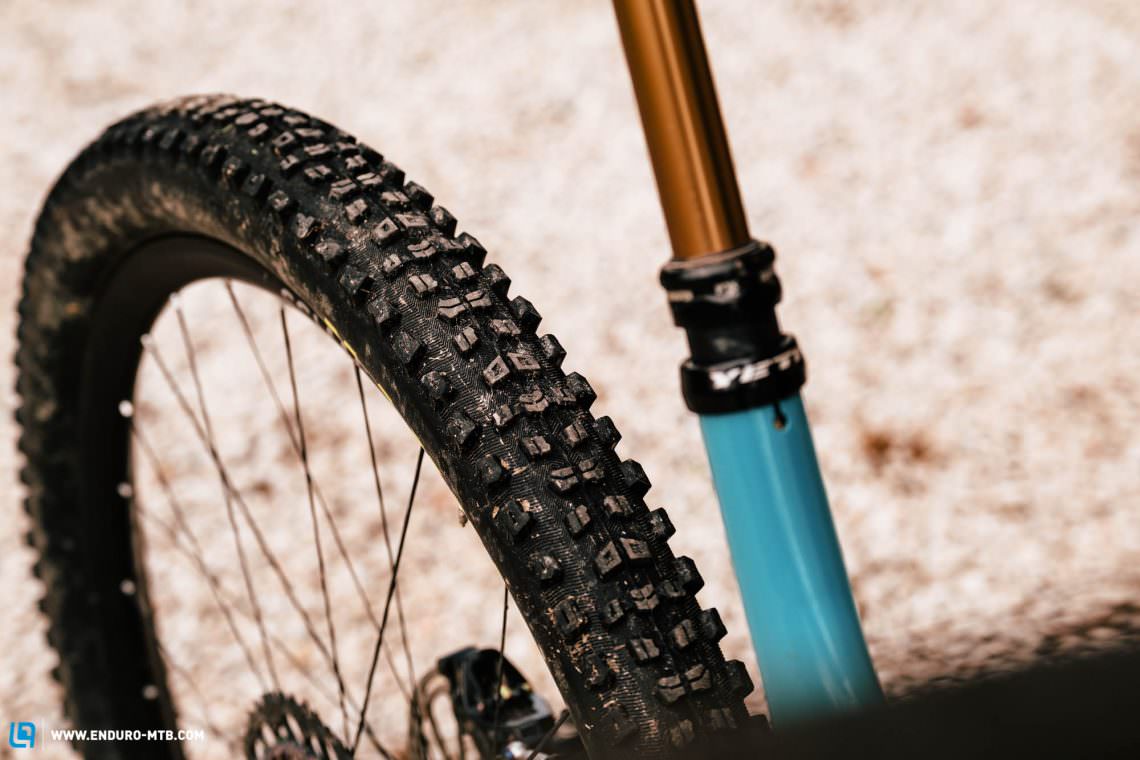
Like, seriously! Don’t we all feel like having a real party again? With its shallow profile and hard rubber compound, the MAXXIS Aggressor won’t expand your KOM collection but still puts a massive grin on your face when you hit a corner. BRAAAAP!

Not much! That’s what we’d love to say. In reality, it’s the horrendous noise we heard when the DT Swiss XRC 1200 SPLINE wheelset packed in during our test! The wheelset didn’t survive the rock garden and therefore doesn’t do justice to the potential of the bike. That’s how you turn a “Woohoo” into an “Ouuch” – with a bang…
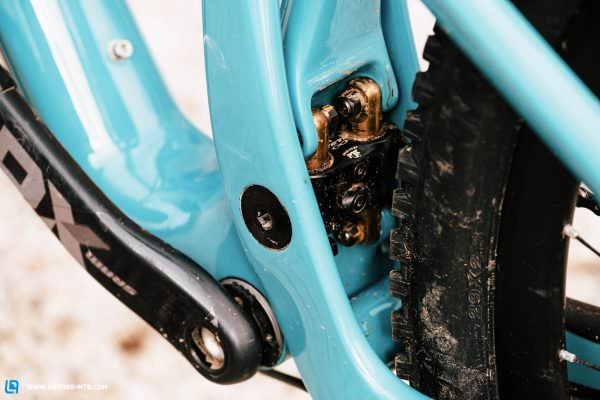
The Switch Infinity Link sits above the bottom bracket of the Yeti SB115 TORQ3 and is supposed to provide lower anti-squat and more consistent anti-rise. The system should be lubricated on a regular basis. And while you’re at it, check the bolts!
Yeti SB115 TURQ3
€ 10,990
Specifications
Fork FOX 34 FIT 4 130 mm
Rear Shock FOX DPS Factory 115 mm
Seatpost FOX Transfer Factory 175 mm
Brakes SRAM Guide G2 Ultimate 180/180 mm
Drivetrain SRAM XX1 Eagle AXS 1x12
Stem Race Face Turbine 50 mm
Handlebar Yeti Carbon 780 mm
Wheelset DT Swiss XRC 1200 SPLINE 29"
Tires MAXXIS Minion DHF EXO 3C MaxxTerra /Agressor EXO Dual 2.5/2.4
Technical Data
Size S M L XL
Weight 12.38 kg
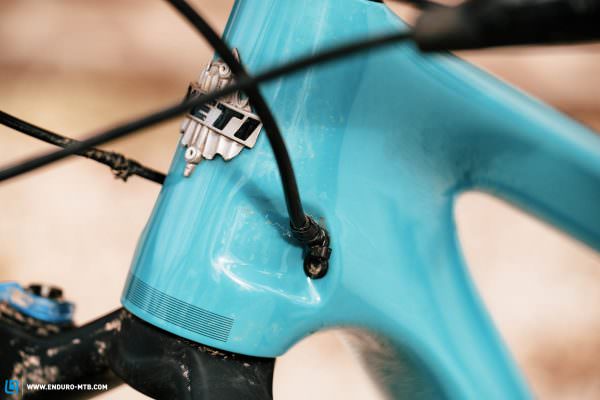
Unfortunately, the internally routed cables are not clamped at the ports, causing a loud rattling noise. We were tired of the noise and secured the cables using conventional zip ties. Not pretty but it does the job.
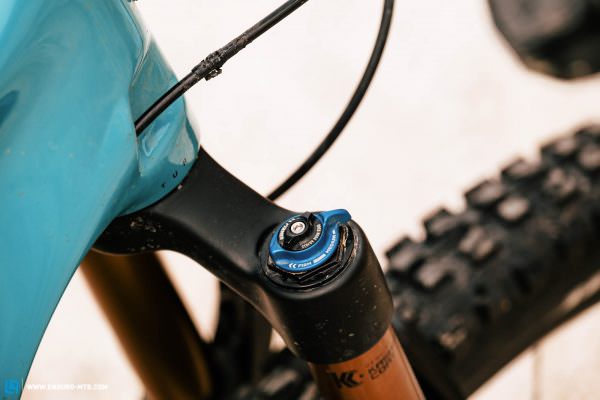
If you pay an eye-watering € 10,990, you should get a superior GRIP2 damper in your fork. We would bee happy to trade in the lockout function of the FOX 34 FIT4 fork for the better damper.
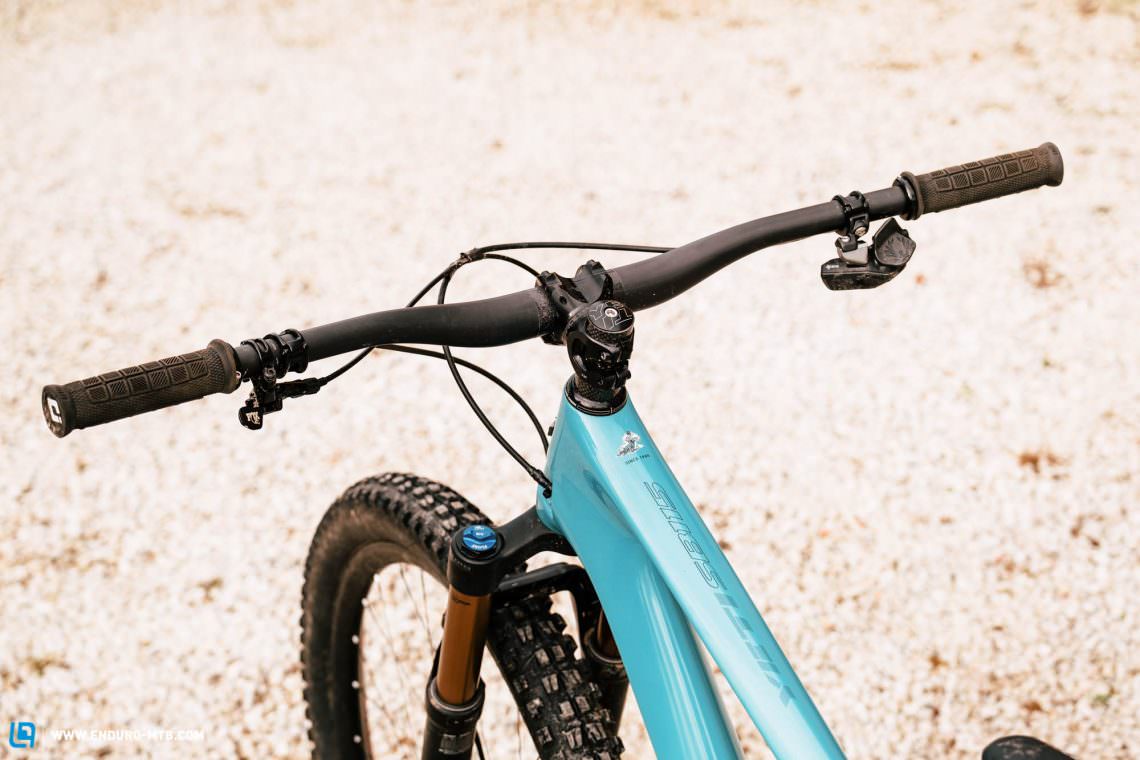
As soon as you swing your leg over the saddle of the Yeti, you feel like you’re sitting on a much more capable bike. Great! The wide 780 mm carbon handlebars and short 50 mm stem let you get rowdy.
Dated? –The geometry of the Yeti SB115 TURQ3 in detail
The Yeti SB115 is available in four frame sizes S–XL, offering a suitable option for riders 155–201 cm tall. The 457 mm seat tube allows for full insertion of the dropper but also makes for a super-compact pedalling position which, in combination with the very short 451 mm reach in size L, restricts the freedom of movement on the bike. If you prefer to choose your bike based on your desired reach, you should be careful because at 495 mm, the seat tube of the size XL is very long. Chainstays are 437 mm across the board, making our size L very nimble. In addition, at 67.1°, the head angle is pretty steep. On paper, the geometry of the Yeti SB115 looks slightly dated.

On the trail, however, the Yeti proves that the overall concept of a bike is far more important than a bunch of numbers on a geo tab – we’ve rarely had as much fun uphill as with the Yeti SB115 TURQ3. The bike sprints like a leopard on speed and is super-efficient, even with the shock fully open. Uphill, the SB115 is the fastest analogue bike on test. With the dropper fully extended, the pedalling position is slightly rear-heavy, which is particularly comfortable on flat trails, making the Yeti suitable for long rides. The low system weight combined with the lightweight wheelset and shallow profile of the rear tire make for a very lively character that encourages you to push hard on the climbs and shift up a gear to get to the top even faster. The Yeti easily pulls past its direct competitors, the MERIDA NINETY-SIX 8000, which can only keep up with the climb switch activated. Despite its outstanding climbing capabilities, even the YT IZZO has to admit defeat uphill: the SB115 just accelerates more willingly and feels more agile and intuitive around corners.
| Size | S | M | L | XL |
|---|---|---|---|---|
| Seat tube | 393 mm | 419 mm | 457 mm | 495 mm |
| Top tube | 577 mm | 606 mm | 631 mm | 658 mm |
| Head tube | 93 mm | 107 mm | 123 mm | 145 mm |
| Head angle | 67.6° | 67.6° | 67.6° | 67.6° |
| Seat angle | 74.1° | 74.1° | 74.0° | 73.9° |
| Chainstays | 437 mm | 437 mm | 437 mm | 437 mm |
| BB Drop | 13 mm | 13 mm | 13 mm | 13 mm |
| Wheelbase | 1,126 mm | 1,155 mm | 1,181 mm | 1,209 mm |
| Reach | 406 mm | 431 mm | 451 mm | 471 mm |
| Stack | 603 mm | 613 mm | 628 mm | 648 mm |
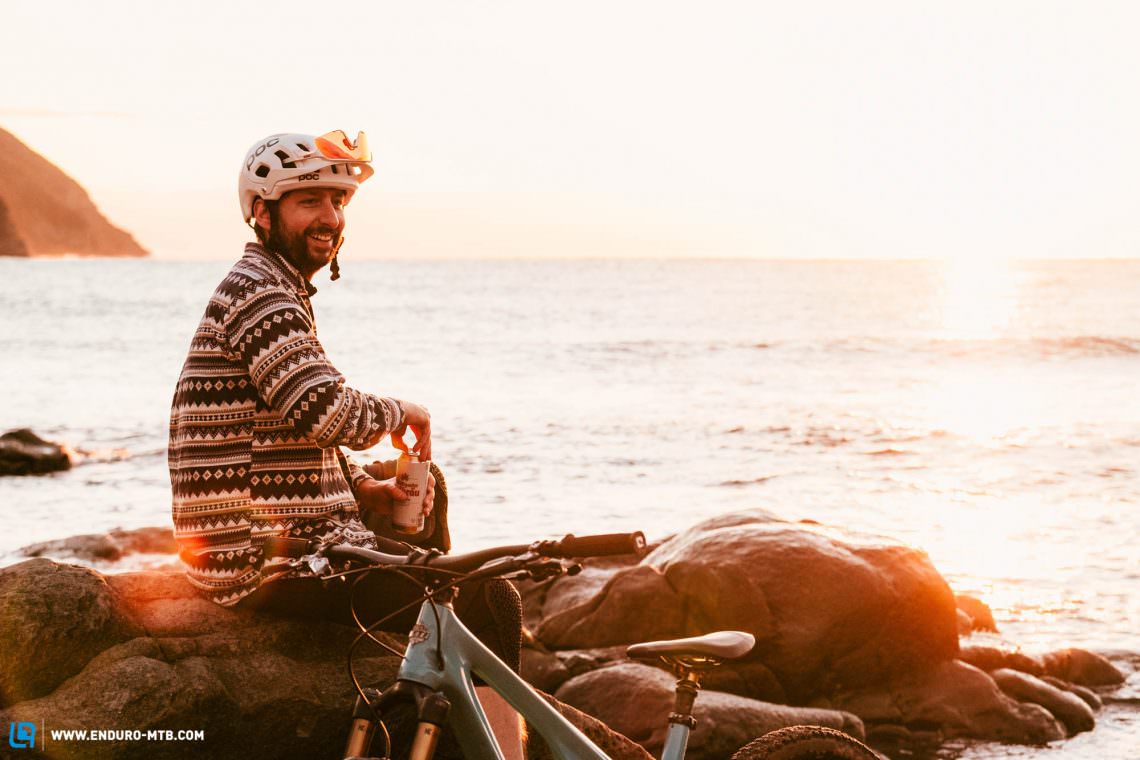
Kneepads Dainese Scarabeo | Shoes Specialized 2FO Cliplite Lace | Socks Stance
Punching above its weight class – The Yeti SB115 TURQ3 on the trail
While most of the test field is still making its way to the trailhead, the Yeti SB115 TURQ3 is already shredding its way down into the valley – and that extremely fast, if you know what you’re doing! With its downhill-oriented components, the cockpit of the Yeti conveys huge amounts of confidence and feels like a much more capable bike, like the Nukeproof Reactor or Canyon Spectral. Downhill, the Yeti shines with clinical precision and urges you to sprint out of every corner at Mach 10 while encouraging you to pull off ledges and steps. This is due partly to the supportive suspension and partly the agile handling, which ensures a playful and agile character and lets you carve through corners as if on rails. Shift your weight over the front wheel and the Yeti generates tons of traction in open corners. It’s in situations like these that the rear tire earns its “party tire” nickname, getting sideways fairly easily yet always staying predictable and leaving making the rear end easy to control.
The Yeti SB115 TURQ3 must have a rocket motor hidden inside the down tube. It’s very rare to see one of our editors shift UP a gear when approaching a climb on an analogue bike.

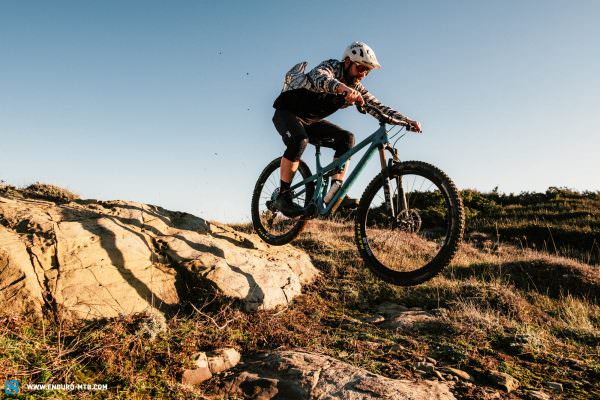
Tuning-tips: volume spacers in the shock | clamp the cables to the ports | 200 mm brake rotors at the front, unfortunately the rear mount only allows up to 180 mm rotors | tall riders should push the saddle all the way forward for a more central pedalling position | more robust tire casing or alloy wheelset
However, at high speeds you’ll soon start wondering how long it will take before you’re standing at the trailside seeking for help. The rear end lacks progression and could lead to severe pinch flats and painful ankles on big steps and harsh compressions. In addition, the FOX 34 fork flexes noticeably in big compressions which can be problematic, especially for riders heavier than 85 kg. If you’re lighter though, this isn’t as much of a problem as with the FOX 34 Step-Cast of the Trek Top Fuel, which suffers from increased lateral flex due to its lightweight construction. All in all, the fork and shock limit the potential of the Yeti and hold you back from opening the gas on rough trails.

Conclusion
With its nimble character and comfortable pedalling position,The Yeti SB115 TURQ3 is a great choice for sporty and experienced riders who are seeking maximum riding fun for fast post-work laps and long rides. With its lively yet efficient character, the Yeti SB115 sets the benchmark for climbing performance. Downhill it feels particularly comfortable on man-made flow trails, where it’s fun, playful and extremely precise. However, the SB115 doesn’t like big compressions or hard hits. The rear lacks progression, causing the shock to blow through its travel quickly and abruptly. That being said, the Yeti still punches well above its weight.
Tops
- super fast and agile uphill
- incredibly playful and fun
- prestigious and extremely good looking
Flops
- cables not clamped at the ports
- rear blows through its travel harshly and suddenl
- tire/wheel combination doesn’t do justice to the potential of the bike, especially downhill
Find more information here: yeticycles.com
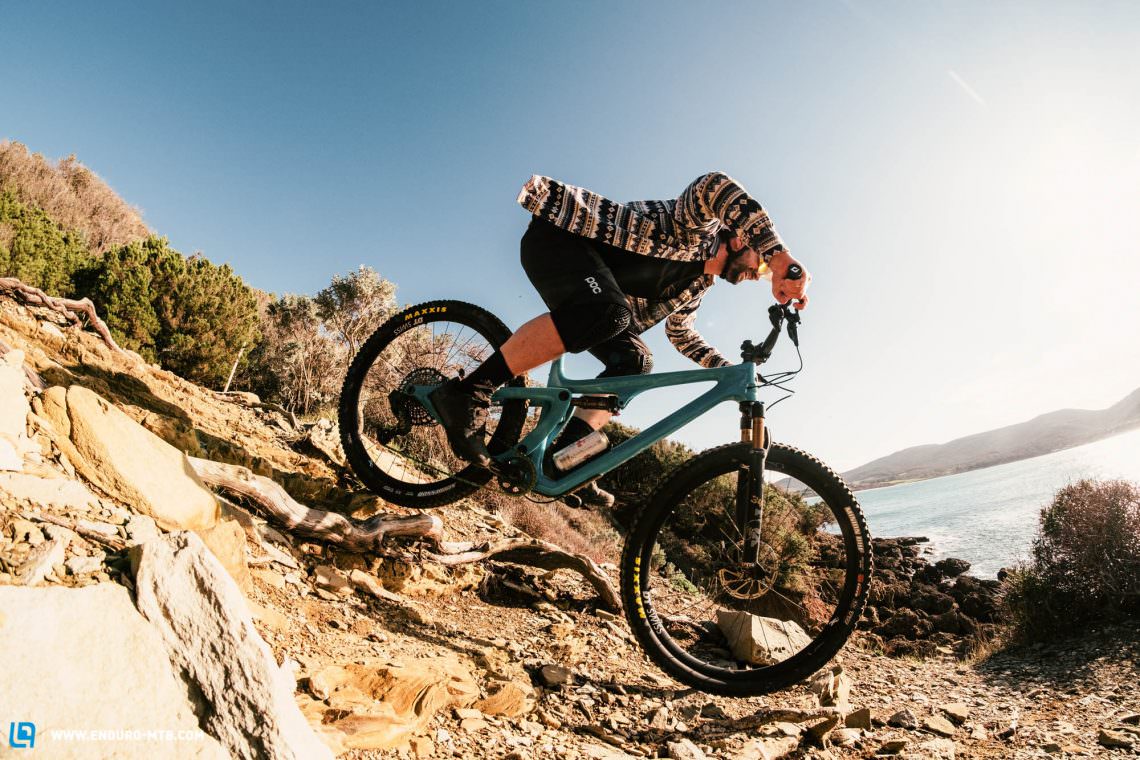
The testfield
Get an overview of the grouptest here: The best mountainbike of 2021 – 22 models in review
All Bikes in this group test: Canyon Neuron CF SLX 9 (Click for review) | Canyon Spectral 29 LTD (Click for review) | Canyon Stoic 4 (Click for review) | FOCUS THRON 6.9 (Click for review) | Ibis Ripmo V2 (Click for review) | MERIDA eONE-SIXTY 10K (Click for review) | MERIDA NINETY-SIX 8000 (Click for review) | Nukeproof Reactor 290C (Click for review) | Orbea Rise M-Team (Click for review) | Propain Hugene (Click for review) | RAAW Jibb XTR Build (Click for review) | Rocky Mountain Instinct C70 (Click for review) | Santa Cruz 5010 X01 (Click for review) | Santa Cruz Tallboy CC X01 (Click for review) | SCOTT Ransom 900 Tuned AXS (Click for review) | Specialized S-Works Stumpjumper (Click for review) | Specialized S-Works Stumpjumper EVO (Click for review) | Specialized S-Works Turbo Levo SL (Click for review) | Trek Fuel EX 9.8 GX (Click for review) | Trek Top Fuel 9.9 X01 (Click for review) | Yeti SB115 TURQ3 | YT IZZO BLAZE 29 (Click for review)

Did you enjoy this article? If so, we would be stoked if you decide to support us with a monthly contribution. By becoming a supporter of ENDURO, you will help secure a sustainable future for high-quality mountain bike journalism. Click here to learn more.
Words: Peter Walker Photos: various









